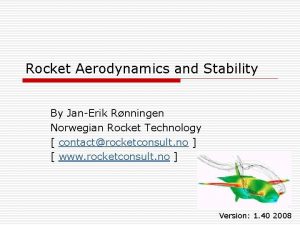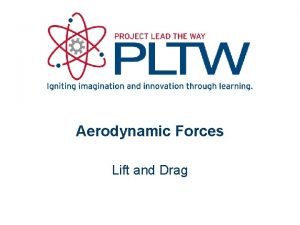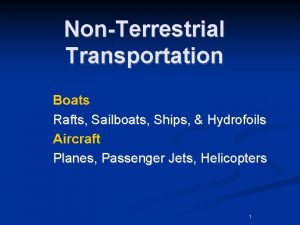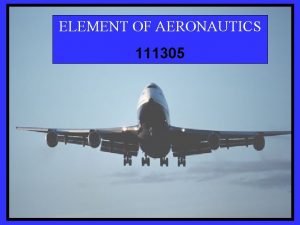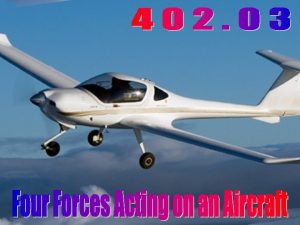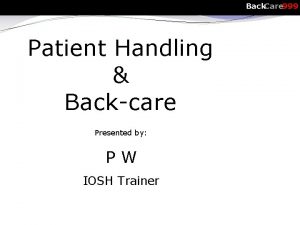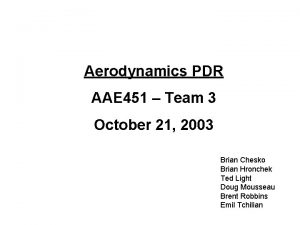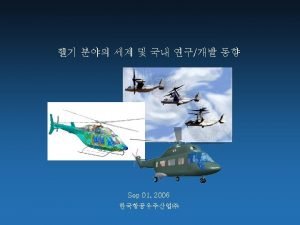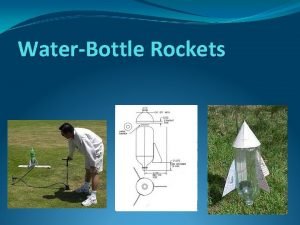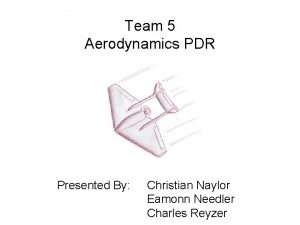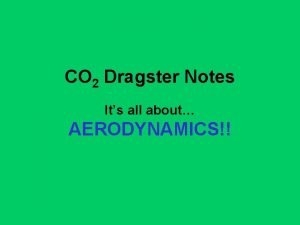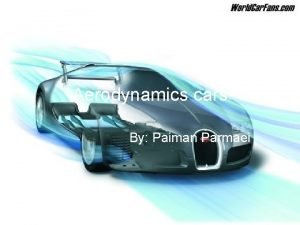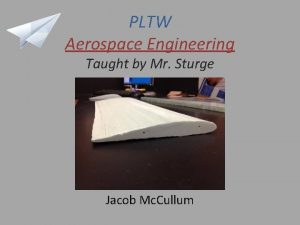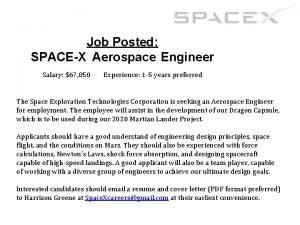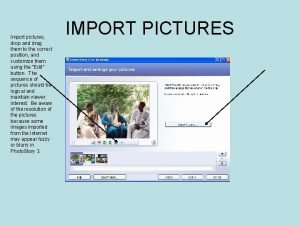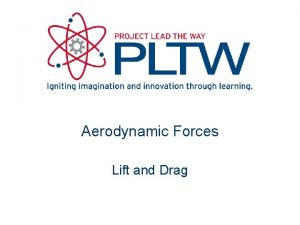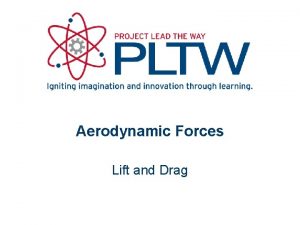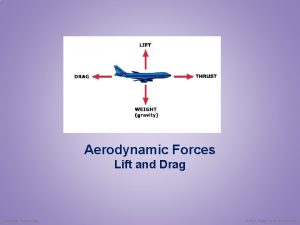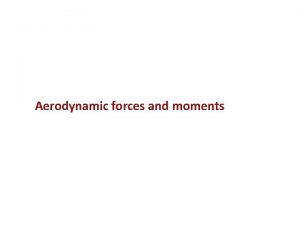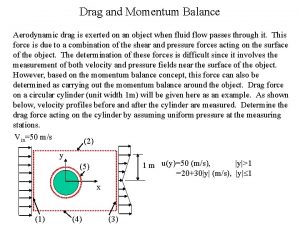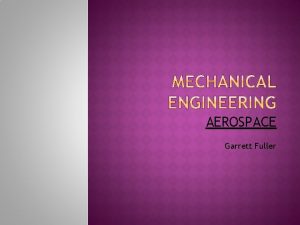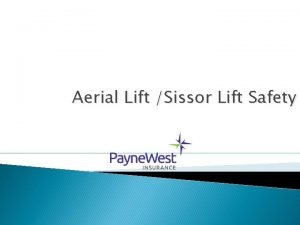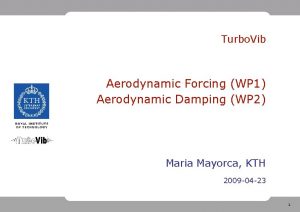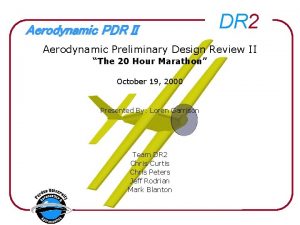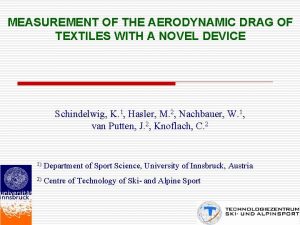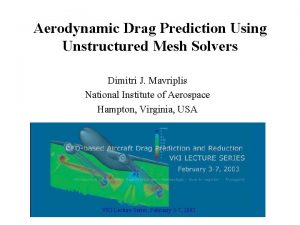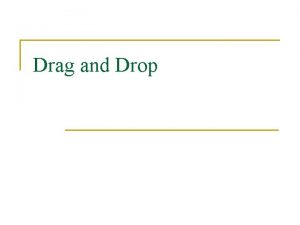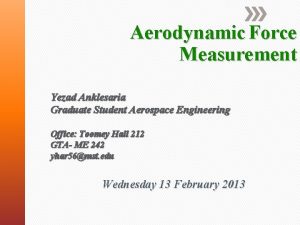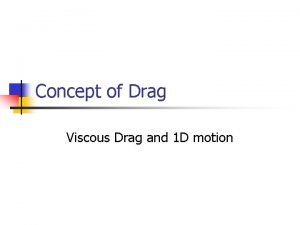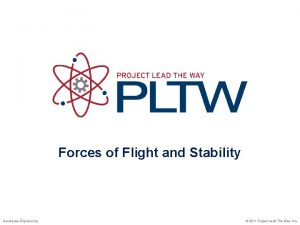Aerodynamic Forces Lift and Drag Aerospace Engineering 2011























- Slides: 23

Aerodynamic Forces Lift and Drag Aerospace Engineering © 2011 Project Lead The Way, Inc.

Lift Equation Lift Coefficient of Lift, Cl – Determined experimentally – Combines several factors • Shape • Angle of attack Alternate format Direction of Flight

Applying the Lift Equation The Cessna 172 from Activity 1. 2. 2 step #2 takes off successfully from Denver, CO during an average day in May (22 OC) with a standard pressure (101. 3 k. Pa). Assume that the take-off speed is 55 knots (102 kph). What is the minimum coefficient of lift needed at the point where the aircraft just lifts off the ground? The Cessna wing area is 18. 2 m 2 and weight is 2, 328 lb (1, 056 kg).

Applying the Lift Equation Convert mass into weight Convert velocity

Applying the Lift Equation Calculate Air Density

Applying the Lift Equation Calculate coefficient of lift assuming that lift equals weight

Boundary Layer • Fluid molecules stick to object’s surface • Creates boundary layer of slower moving fluid • Boundary layer is crucial to wing performance

Boundary Layer and Lift • Airflow over object is slower close to object surface • Air flow remains smooth until critical airflow velocity • Airflow close to object becomes turbulent

Reynolds Number, Re • Representative value to compare different fluid flow systems • Object moving through fluid disturbs molecules • Motion generates aerodynamic forces Airfoil 1 Comparable to Airfoil 2 when Re 1 = Re 2

Angle of Attack (AOA) Affects Lift increases with AOA up to stall angle Airflow Lift Direction of Flight Lift Stall Lift Direction of Flight Angle of Attack

Reynolds Number • Ratio of inertial (resistant to change) forces to viscous (sticky) forces • Dimensionless number or

Applying Reynolds Number A P-3 Orion is cruising at 820 kph (509 mph) at an altitude of 4, 023 m (13, 198 ft). Assume a fluid viscosity coefficient of 1. 65 x 10 -5 N(s)/m 3. What is the average Reynolds Number along a wing cross section measuring 1. 1 m (3. 6 ft) from leading edge to trailing edge? Need components to calculate Re

Applying Reynolds Number Calculate Air Temperature Calculate Air Pressure

Applying Reynolds Number Calculate Air Density

Applying Reynolds Number Convert Velocity

Applying Reynolds Number Calculate Re

Drag Equation Drag Coefficient of drag, Cd – Determined experimentally – Combines several factors • Shape • Angle of attack Alternate format Direction of Flight

Coefficient of Drag (Cd) Object shape affects Cd

Applying the Drag Equation The same Cessna 172 from Activity 1. 2. 2 step #2 takes off under the same conditions as described earlier in this presentation. How much drag is produced when the wing is configured such that the coefficient of drag is 0. 05?

Applying the Drag Equation Calculate drag

Downwash and Wingtip Vortices • Pressure difference at wing tips • Air to spill over wingtip perpendicular to main airflow • Air flows both upward and rearward, forming a vortex • Decreases lift • Increases drag

Wingtip Vortices • Air flows both upward and rearward, forming a vortex • Winglets are vertical airfoils that limit vortices and improve fuel efficiency

Reference National Aeronautics and Space Administration (2011). Aerodynamic forces. Retrieved from http: //www. grc. nasa. gov/WWW/K 12/airplane/presar. html National Aeronautics and Space Administration (2011). Reynolds number. Retrieved from http: //www. grc. nasa. gov/WWW/BGH/reynolds. html National Aeronautics and Space Administration (2011). Winglets. Retrieved from http: //www. nasa. gov/centers/dryden/about/Organizations/Technolog y/Facts/TF-2004 -15 -DFRC. html Raymer, P. (2006). Aircraft design: A conceptual approach. Reston, VA: American Institute of Aeronautics and Astronautics.
 Aerodynamics of rockets
Aerodynamics of rockets Lift equation
Lift equation Lift drag thrust weight
Lift drag thrust weight Lift drag thrust weight
Lift drag thrust weight Lift weight thrust drag
Lift weight thrust drag Mnemonic fluency manual handling
Mnemonic fluency manual handling Drag coefficient at zero lift
Drag coefficient at zero lift Lift drag thrust weight
Lift drag thrust weight Water bottle rocket designs
Water bottle rocket designs Mean aerodynamic chord
Mean aerodynamic chord Least aerodynamic shape
Least aerodynamic shape Aerodynamic dragster
Aerodynamic dragster Aerodynamic shape vs aerofoil shape
Aerodynamic shape vs aerofoil shape Aerodynamic devices
Aerodynamic devices Pltw aerospace engineering
Pltw aerospace engineering Metu aerospace engineering
Metu aerospace engineering Aerospace engineering solutions
Aerospace engineering solutions Phystech international
Phystech international How much does an aerospace engineer make at spacex
How much does an aerospace engineer make at spacex Like parallel forces diagram
Like parallel forces diagram Contact force
Contact force Net force
Net force Constructive forces examples
Constructive forces examples Drag and drop picture and signature at the correct position
Drag and drop picture and signature at the correct position
